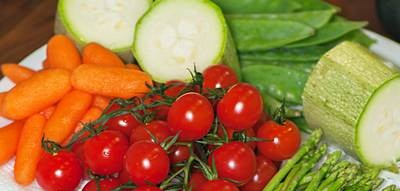|
 At the end of the last and the beginning of this century, the extremely important role of vitamins and microorganisms in the physiological processes in the human body was discovered. This discovery dramatically changed the attitude towards vegetables and fruits. It turned out that the energy properties of food and the abundance of proteins in it alone are not enough for the smooth operation of a healthy body. The source of essential substances for life - vitamins C and P - turned out to be vegetables and fruits, which had previously been neglected. At the end of the last and the beginning of this century, the extremely important role of vitamins and microorganisms in the physiological processes in the human body was discovered. This discovery dramatically changed the attitude towards vegetables and fruits. It turned out that the energy properties of food and the abundance of proteins in it alone are not enough for the smooth operation of a healthy body. The source of essential substances for life - vitamins C and P - turned out to be vegetables and fruits, which had previously been neglected.
The presence and absence of these vitamins and many minerals in various products is demonstrated by the following table.
|
Group
products
|
What does the body get from them
|
What substances are too few
|
|
Milk, cottage cheese,
|
Complete proteins
|
Iron, vitamins
|
|
cheese
|
fats, sugar, calcium, phosphorus, vitamins A, D, Bg, Sun
|
C and P
|
|
Meat, fish, quantity
|
Complete proteins
|
Carbohydrates,
|
|
bass, canned food
|
(fats), iron, B vitamins
|
calcium, vitamins C and P
|
|
Eggs
|
Complete proteins, fats and lipoids, calcium, phosphorus, iron, vitamins A, D and B
|
Carbohydrates, vitamins C and P
|
|
Groats, flour,
|
Starch, defective
|
Full-fledged
|
|
black and
|
ny proteins, vitamins
|
proteins, fats,
|
|
White bread
|
group B (peel), phosphorus
|
vitamins C, P and A, minerals with an alkaline residue
|
|
Sugar, jam, caramel
|
Sugar
|
All other nutrients
|
|
Butter, margarine,
|
Fats, lipoids, vitamins
|
Proteins, carbohydrates,
|
|
vegetable
oil
|
mines A, D, F
|
vitamins of group C, P and B, minerals
|
 Sugar, fiber, vitamins C, P, K, carotene (provitamin A), all the necessary minerals (K, Ca, Fe, Mg, Cu, J, Mn, etc.), spices - Fats, proteins, sugar, group vitamins B, minerals Sugar, fiber, vitamins C, P, K, carotene (provitamin A), all the necessary minerals (K, Ca, Fe, Mg, Cu, J, Mn, etc.), spices - Fats, proteins, sugar, group vitamins B, minerals
Vitamin C content in 100 g of food, in mg
Milk, sour cream, cottage cheese, cheese, meat, fish ....................................... 1-5
Watermelons, cucumbers, pumpkin, carrots, blueberries, pears, grapes .......... 3-7
Potatoes, beets, onions, bananas, cranberries, canned peas 10
Cherries, lingonberries, tomato juice ............................................ .................... 15
Turnip, radish, radish, sauerkraut, blueberry, spinach puree ... 20
Fresh peas, tomato puree, Antonov apples ... 25
Rutabaga, cabbage, lettuce, cloudberries, raspberries, tangerines, currants ... 30
Tomatoes, oranges, lemons, dried apples ... 4.0
Gooseberry, mountain ash, spinach ............................................. ......................... fifty
Sorrel, green onions, strawberries ............................................ .................... 60
Cauliflower, tangerine zest ............................................. ......... 70
Dill, parsley, strawberries 150
Horseradish ................................................. .................................................. ....... 200
Capsicum (red) ............................................. ............. 250
Black currant................................................ .................................... 300
Rose hips, green walnuts (unripe) ............. 1200
Proceeding from the fact that a person's daily requirement for vitamin C is 50-100 mg, according to the above table, it is easy to select products that provide vitamin C in sufficient quantities.
However, it must be remembered that ascorbic acid is destroyed during cooking and heating. Therefore, it is recommended to use foods containing vitamin C raw in salads and fruit drinks.
Vitamin P (rutin, citrine) is usually found in foods along with vitamin C, increasing its effect. It has a beneficial effect on the condition of the capillaries. Vitamin P is rich in all green leafy vegetables, as well as black currants, rose hips, red peppers, lemons and oranges.
Vitamin PP (nicotinic acid) promotes protein metabolism, increases human capacity for work, has a beneficial effect on the condition of the skin, muscles and nerves. This vitamin is found in potatoes, spinach, onions, peas, tomatoes, plums, and many other fruits and vegetables.
Vitamin K promotes blood clotting and teeth preservation. It is especially abundant in cabbage, spinach, nettles, in all green parts of plants, in many vegetables and fruits.
Carotene is a yellow coloring agent found in carrots, red peppers, green vegetables and rose hips. In the body, under the influence of enzymes, it turns into vitamin A, which has a beneficial effect on vision and growth and strengthens the mucous membrane. Vitamin A is found in fruits and vegetables as well as in other foods.
Minerals
All vegetables and fruits are rich in alkaline minerals. They are especially rich in potassium, calcium, iron, magnesium and trace elements - copper, iodine, manganese. True, there are fewer of them in vegetables than in meat, but still quite a lot (on average 10%, in meat - 20%).
The content of minerals in 100 g of products, in mg
|
Name
product
|
Potassium
|
Calcium
|
Iron
|
Phosphorus
|
|
Potatoes
|
568
|
10
|
1,2
|
50
|
|
White cabbage
|
185
|
48
|
1,1
|
31
|
|
Beet
|
194
|
28
|
1,4
|
43
|
|
Carrot
|
161
|
43
|
0,8
|
39
|
|
Onion
|
182
|
38
|
0,8
|
58
|
|
Cucumbers
|
148
|
23
|
1,0
|
27
|
|
Tomatoes
|
177
|
12
|
1,4
|
26
|
|
Fresh apples
|
98
|
19
|
2,5
|
13
|
|
Fresh plums
|
214
|
28
|
2,1
|
27
|
|
Beef
|
305
|
10
|
2,7
|
194
|
|
Herring
|
307
|
20
|
1,0
|
211
|
The table shows that there is little calcium in meat and fish compared to vegetables. But in vegetables and fruits there are few substances that give an acid residue. This is also a positive indicator.
Salme Masso. Salads and refreshments
|
 At the end of the last and the beginning of this century, the extremely important role of vitamins and microorganisms in the physiological processes in the human body was discovered. This discovery dramatically changed the attitude towards vegetables and fruits. It turned out that the energy properties of food and the abundance of proteins in it alone are not enough for the smooth operation of a healthy body. The source of essential substances for life - vitamins C and P - turned out to be vegetables and fruits, which had previously been neglected.
At the end of the last and the beginning of this century, the extremely important role of vitamins and microorganisms in the physiological processes in the human body was discovered. This discovery dramatically changed the attitude towards vegetables and fruits. It turned out that the energy properties of food and the abundance of proteins in it alone are not enough for the smooth operation of a healthy body. The source of essential substances for life - vitamins C and P - turned out to be vegetables and fruits, which had previously been neglected.





